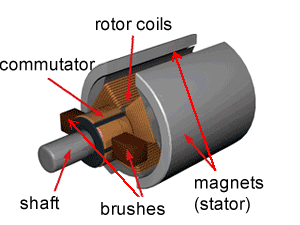armature

A small DC motor. The armature consists of the rotating coils and the core around which they are wound.
The armature is the part of an electric motor and generator which includes the principal current-carrying windings. In small motors, such as the one shown here, the armature usually consists of a number of coils of wire wound on a soft iron core and mounted on a drive shaft. In larger AC motors, on the other hand, the armature is often the stationary component. When a current flows in the armature winding of a motor, it interacts with the magnetic field produced by the field windings giving rise to a torque between the rotor (the revolving part of the machine) and stator (the stationary part). In the generator the armature is rotated in a magnetic field giving rise to an electromotive force in the windings.
The armature is essentially a conductor (or conductors) arranged to cut the lines of a magnetic field at right angles. Both the field and the armature may be on either the stator or rotor. By a basic principle of electromagnetism, a voltage is induced in a conductor that moves in a magnetic field and a conductor in a magnetic field experiences a force and tends to move when a current flows through it.
To make the best use of this basic effect, the magnetic and electrical elements in electrical machines (the field and armature) have to interact in the most efficient manner possible. The armature is generally wound on an iron core which concentrates the maximum number of flux lines. The field coils are also wound on iron cores, to produce the maximum flux for a given current. The iron for both the field and the armature is sometimes laminated – that is, made up of slices. This prevents the currents from circulating and 'eddying' in the iron itself and generating wasted heat, as a result of changing magnetic flux in the machine.
The armature must be supplied with a current (through rotating contacts) if it is the rotor in a motor and there must be a way of taking current from it if it is a generator. The same applies to the field if it is electrically energized. The rotating contact arrangement can be either a set of slip-rings or a commutator. These rotate under fixed contacts, called brushes, made of carbon and held in place by springs. From time to time the brushes have to be replaced when the carbon wears away.


